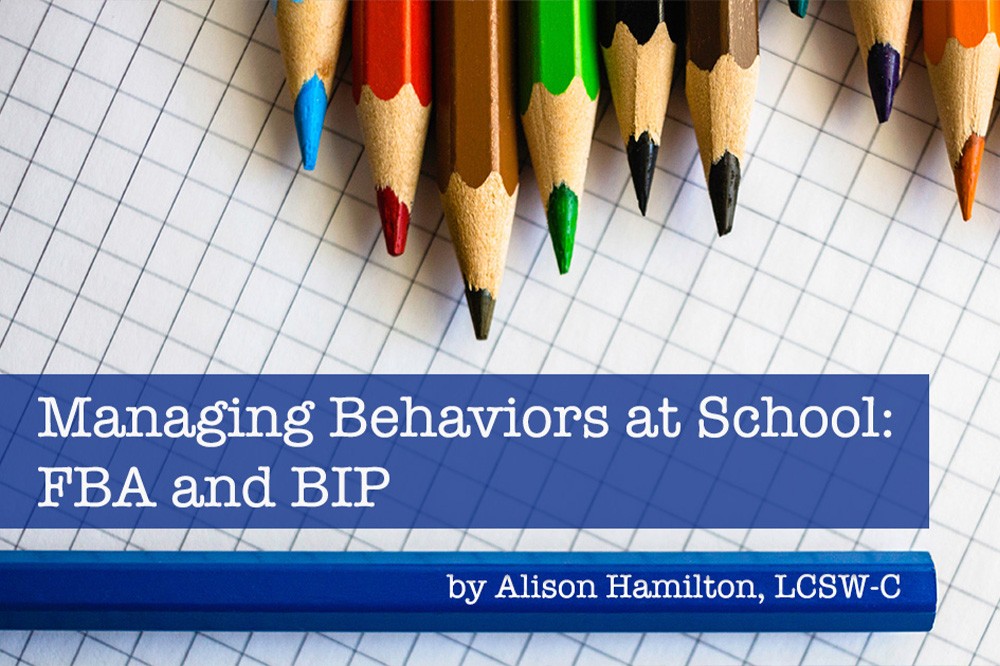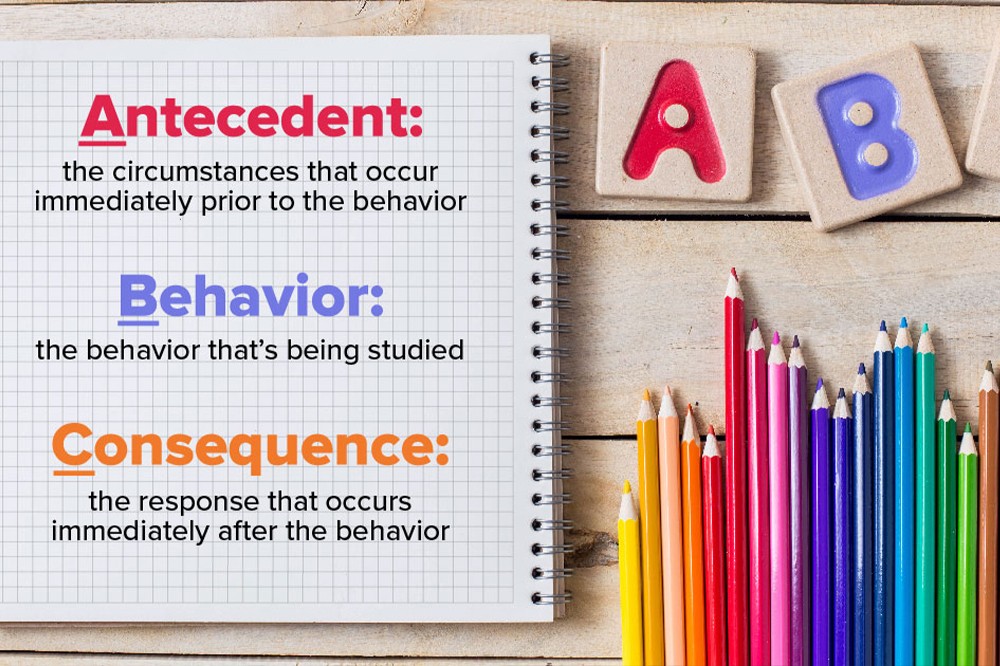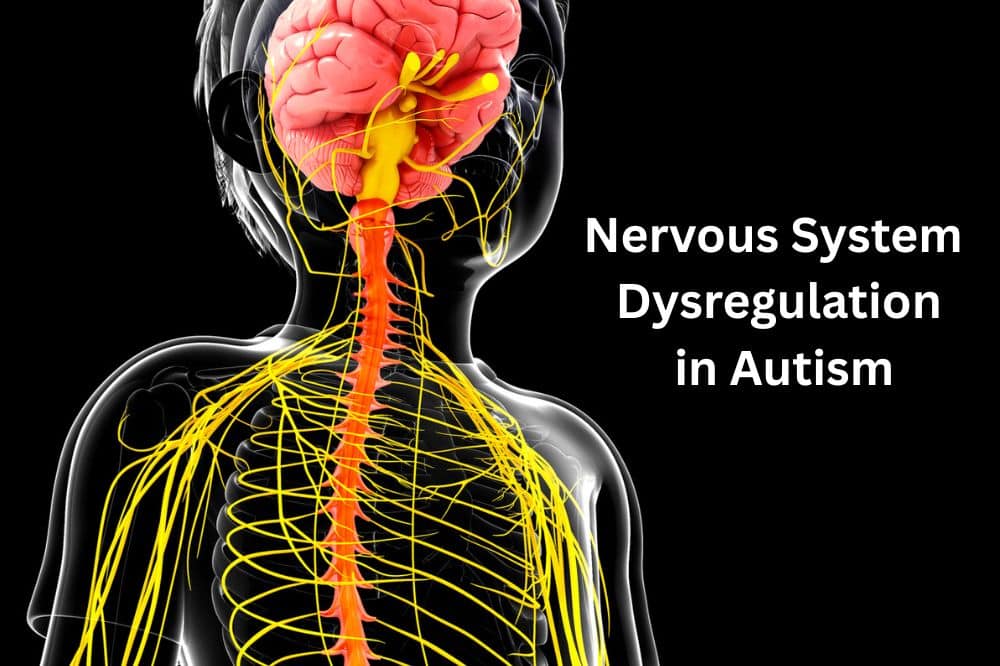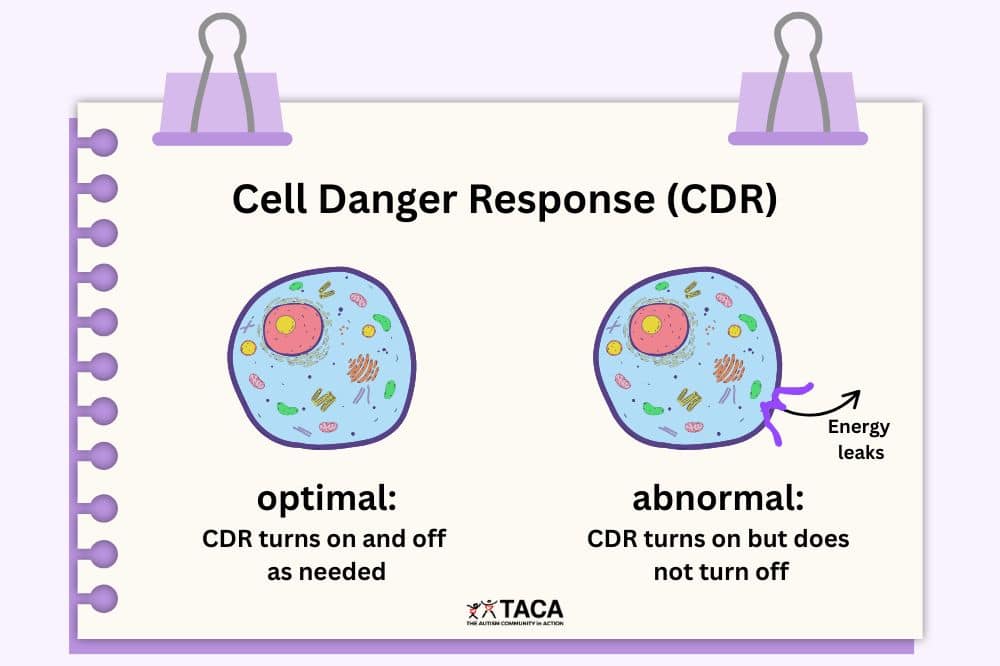Managing Behavior at School: FBA and BIP

All contents of this resource were created for informational purposes only and are not intended to be a substitute for professional advice, diagnosis, or treatment. Always seek the advice of your physician, therapist, or other qualified health providers with any questions or concerns you may have.

Alison Hamilton, LCSW-C
Imagine a child in math class, at a time when the students are expected to work independently. With a shout, the child sweeps papers, textbook, and pencils off the desk, drawing stares from peers and an immediate response from the teacher.
A number of factors influence what happens after the child’s supplies end up on the floor, including the child’s age and grade level, the personality of the teacher, the school culture, and whether and how often an incident like this has happened before. In most schools, removals from class or loss of privileges (like recess, for example) are likely consequences.
Now imagine that child has autism and an IEP. How the classroom teacher and school respond to this incident, as well as any other interfering behaviors, will affect the child’s success at school and progress toward IEP goals. An effective deterrent for a typically developing student may be just the opposite for a student with autism, encouraging the unwanted behavior instead of extinguishing it. As problem behaviors go up, it’s reasonable to assume that time spent learning and interacting appropriately with peers – the reasons the child attends school in the first place – will go down.
IDEA is clear about the obligations of schools to consider special factors, including behavior, that impair a student’s learning or the learning of others. IEP teams are expected to use “positive behavioral interventions and supports, and other strategies” to alleviate problem behaviors. The law requires a Functional Behavioral Assessment (FBA) if the IEP team determines that the behavior is a manifestation of the child’s disability (34 CFR §300.530(e). The FBA should be used to develop IEP goals to address the behaviors; the IEP can also incorporate a Behavior Intervention Plan (BIP) if needed.
How Do I Request an FBA?
Call an IEP team meeting, in writing. At the meeting, plan to discuss the reasons your child’s behavior is a manifestation of her disability. If the rest of the team agrees with you, then an FBA is necessary. An FBA is considered an evaluation, so parent consent is required to perform it, as with any other type of evaluation done by the school system.
Who Should Perform an FBA?
A good, thorough FBA requires someone with expertise in both autism and behavior; ideally, a Board-Certified Behavior Analyst (BCBA).
How is an FBA Completed?
Remember that the first word in the acronym is ‘functional’. An effective assessment should determine why an undesirable behavior is occurring. When autism is involved, the ‘why’ can be unexpected and not particularly straightforward.
If one of my typically developing daughters had the math outburst and was sent to the principal’s office, she’d be mortified. The embarrassment of losing control in front of her classmates, coupled with a healthy fear of what school authority figures might say when she got to the office, would be enough to deter her from ever repeating the behavior.
In contrast, my daughter with autism’s first post-outburst thought would likely be, “Score. I got out of math class.” She is not particularly prone to embarrassment, and any negative attention in the principal’s office would be tolerable to her, given the payoff of avoiding math. Unlike her sister, my daughter with autism would be very likely to repeat the behavior the next time she didn’t like the look of her math classwork.
It’s important to look hard at the ‘why’ behind every interfering behavior by interviewing people who are involved with the child, observing the child, and collecting and analyzing data.
1. Interview
The assessor should begin by gathering background information from the school team and the parent.
- Imagine you’re the parent of the child who had the outburst in math. You can probably expect to field questions about whether math has been a problem for him before and his relationships with classmates, teachers, and any support staff.
- Work samples and test grades might either support or refute the idea that math itself is the source of stress.
Interviews and a review of school records might give the assessor a starting point, but they are not sufficient on their own to build an accurate FBA.
2. Observation and Data Collection
Timing, frequency, and duration of a behavior provide further clues about its purpose, as well as baseline data that can be used to measure progress later on, after IEP goals and a BIP have been implemented.
- Returning to the math outburst, how often have similar outbursts occurred? (Since you’re doing an FBA, let’s assume they’re frequent enough to get the IEP team’s attention.) Are they only happening in math, or are they happening in other classes too?
Do the outbursts happen at the same time of day, regardless of the subject being taught? Have the outbursts happened in previous school years, or is this a new behavior? (Be aware that the longer an interfering behavior continues, the harder it will be to correct it. It’s important to be proactive about requesting an FBA when needed.)
If the behavior is confined to math, that may be a clue that either math itself or the math classroom environment is a trigger.
After talking to the teacher and observing the class, the assessor may note that your child sits close to a class clown with a reputation for picking on kids who are different.
3. ABC Data Collection and Analysis
Timing, frequency, and duration data may provide a lot of insight, but to develop a complete picture, the assessor should also use ABC data collection.

- The A stands for antecedent, or the circumstances that occur immediately prior to the behavior.
- B represents the behavior that’s being studied.
- C stands for the consequence – i.e. the response that occurs immediately after the behavior.
Analyzing behavior this way can show what the child is gaining from the negative behavior. Here are a couple of ABC possibilities, based on the math outburst example:
Example 1:
A. Long division classwork is passed out. The worksheet is double-sided, with multiple problems on each side of the paper. The rest of the class begins working; the child stares at the paper, but does not attempt the work.
B. The child shouts and sweeps class materials off the desk.
C. The child is sent to the office; the teacher wants him to calm down.
Analysis: The assessor decides that the payoff for the student is work avoidance. Either the child is finding long division difficult, or she is finding the presentation overwhelming (double-sided sheet with a lot of problems).
Example 2:
A. Long division classwork is passed out. The class begins working; the class clown softly hums a few bars of the ‘Barney’ theme song.
B. The child shouts and sweeps class materials off the desk.
C. The child is sent to the office; the teacher wants him to calm down.
Analysis: Parent and teacher interviews have already revealed that the child has auditory sensitivities, as well as strong likes and dislikes. The peer in this case appears to be trying to cause an outburst. The payoff for the child is escape from the trigger.
Developing a Plan
A BIP and any behavior-related IEP goals and objectives should be individualized based on the results of the FBA. A BIP is NOT intended to be a system of consequences to use if a student breaks rules. The BIP should focus on replacing problem behaviors with appropriate ones, including adding supports and making any necessary environmental changes to support the desired behaviors.
In Example 1, the payoff for the student is work avoidance. If the student’s grades and work samples suggest struggles with math, the IEP team should consider whether extra special education services in math are needed. The BIP should include alternate ways of presenting the work (fewer problems on one page, for example) and positive behavior supports. The team could consider an incentive system to encourage the child to attempt non-preferred tasks. An IEP goal related to self-advocacy skills could also be added to address asking for help when the student feels overwhelmed.
In Example 2, the payoff for the student is escape from the classmate and the trigger. The BIP should include environmental modifications, such as seating the student away from this peer or providing a quiet break area. (Hopefully, once this trigger has been observed, the school staff will also have addressed it with the peer.) The student should be helped to develop self-advocacy skills, particularly when he feels overwhelmed, via the BIP and an IEP goal.
In both cases, the goal is to keep the child out of the office, in math class, and available for learning.
It’s important to communicate regularly with school staff to monitor progress. Behavior modification can take time. If your child’s BIP does not appear to be doing the job, consider a few things:
- Extinction bursts.
- If the BIP is fairly new, you may be seeing an extinction burst, in which unwanted behaviors increase before they decrease. Your child may be testing the school team to make sure the familiar behavior really won’t work anymore.
- Are rewards compelling?
- Make sure any behavior incentives are motivating for your child. It can be helpful to work with the school to develop a list of incentives for your child to choose from. It’s normal for rewards to fall in and out of favor.
- Do supports need to be adjusted?
- Make sure your child has been explicitly taught how to access any supports outlined in the BIP or IEP, and that they continue to meet her needs.
- Is the school implementing the BIP consistently?
- Regular, professional communication with the team will help you assess this. Keep as calm as you can. The school team is more likely to be open if they aren’t on the defensive.
- Did the FBA miss the mark?
- Some kids are complicated, or some assessors do a poor job.
If the FBA is Wrong
If you disagree with an FBA, you can request an Independent Educational Evaluation (IEE), just as you would if you disagree with any other evaluations done by your school district. The district then has two options: Schedule a due process hearing to defend their FBA, or pay for the independent evaluation. Many districts (though not all, unfortunately) will recognize that the IEE is the more cost-effective option.
Be Proactive
If you are concerned that your child’s behavior is interfering with instructional time, call your IEP team together to discuss developing or updating an FBA and BIP. The school does not have to be making noises about a placement change for these discussions to happen. Try to look at the situation from your child’s point of view, too. Remember that all behavior is an attempt to communicate; if your child is having ongoing behavior issues, she is asking the adults in her world to help her fix what isn’t working.




